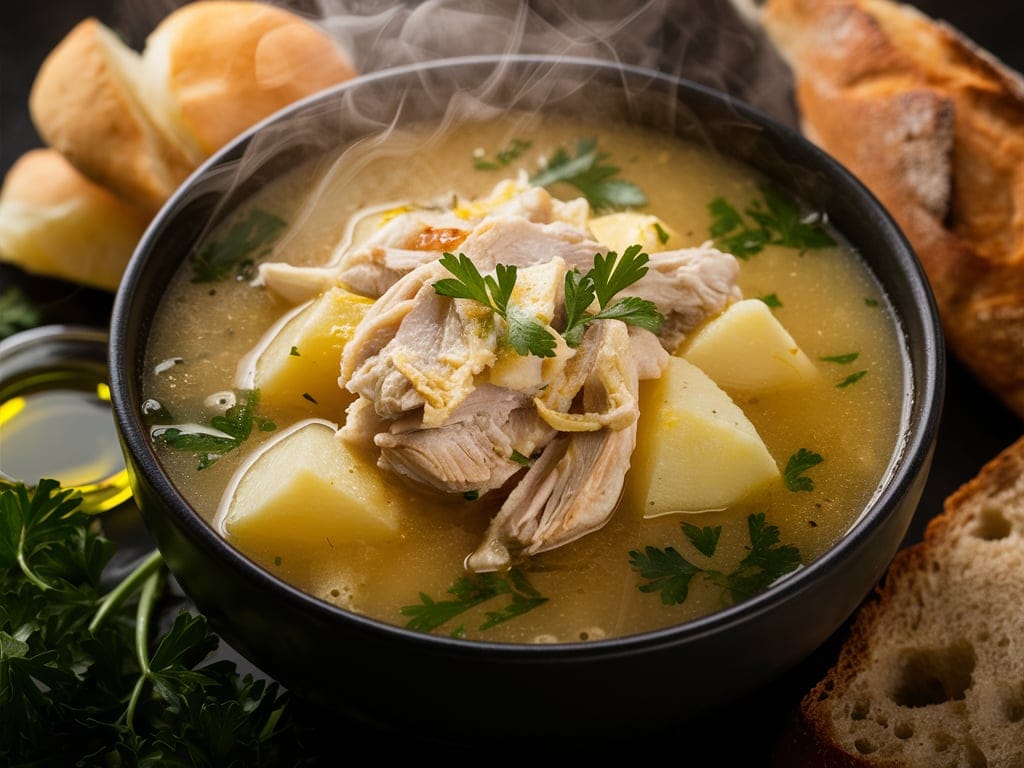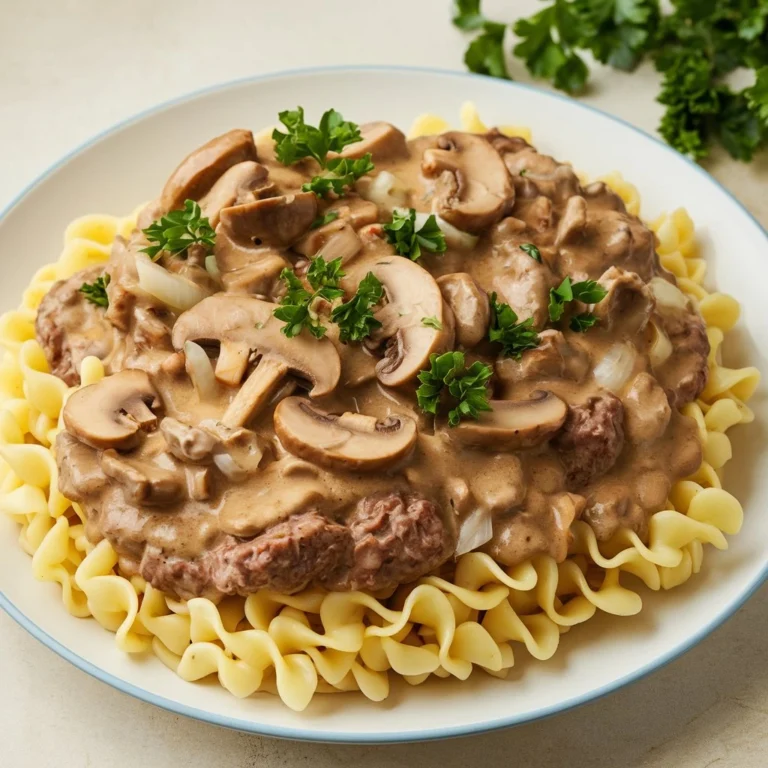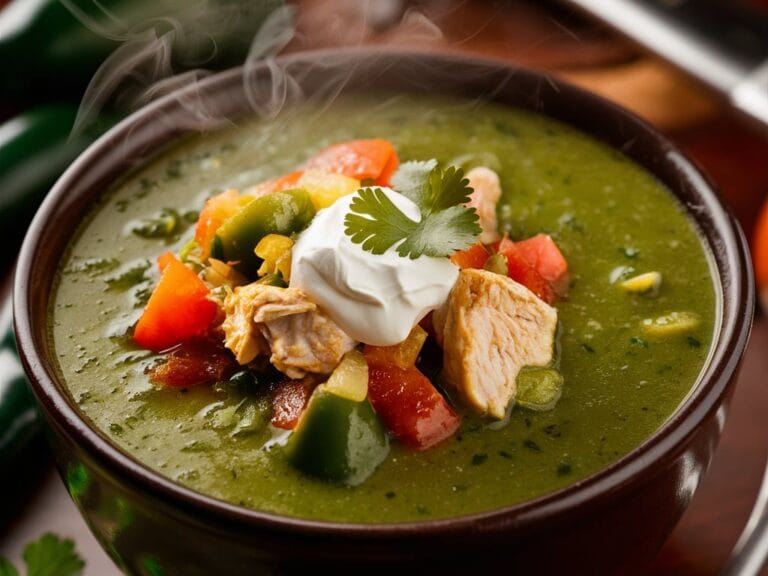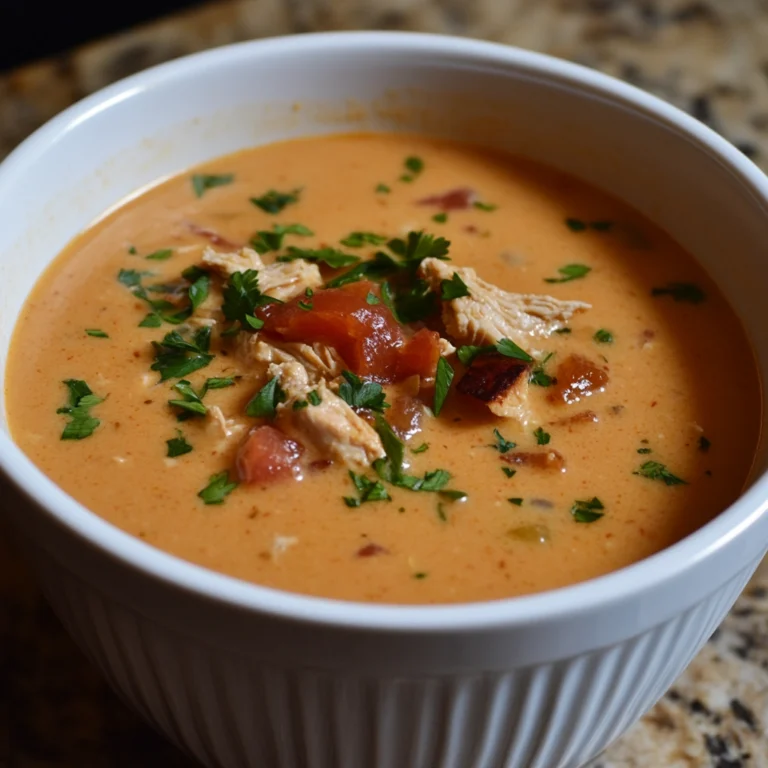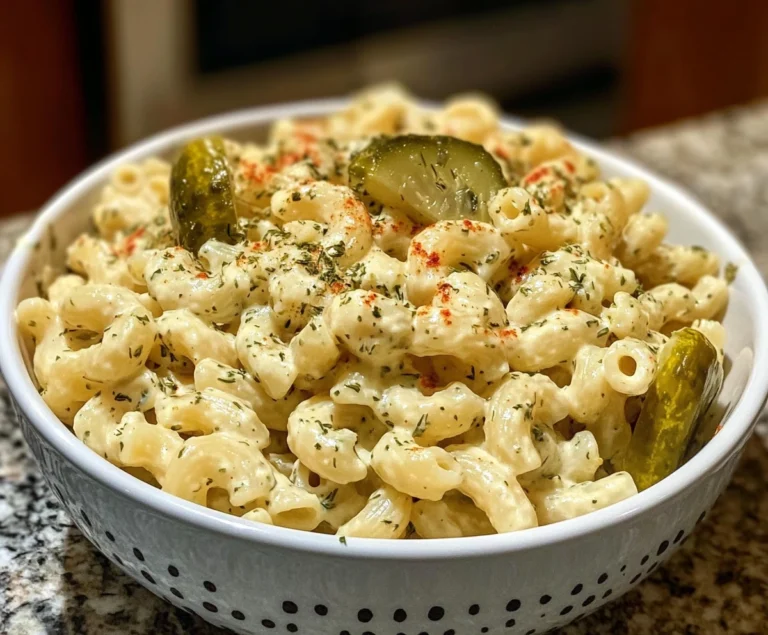Chicken Potato Soup Recipe: A Comforting, Hearty Delight
When the weather turns chilly, there’s nothing quite like a bowl of warm, comforting chicken potato soup recipe. This hearty dish is perfect for cozy family dinners, providing both nutrition and comfort in every spoonful. Whether you’re an experienced cook or just starting in the kitchen, this recipe is easy to follow and highly adaptable to your taste preferences.
In this article, we’ll walk you through every aspect of making chicken potato soup, from selecting the best ingredients to experimenting with different cooking methods and serving ideas. We’ll also cover variations to suit dietary needs and preferences, tips for ensuring a perfect outcome, and common questions that might arise during the cooking process. With this guide, you’ll have everything you need to create a delicious and satisfying meal that can be enjoyed throughout the year.
Ingredients to Chicken Potato Soup Recipe
To make the perfect chicken potato soup, you’ll need a few simple ingredients that come together to create something truly special. Here’s what you’ll need:
- 2 cups of cooked chicken (rotisserie or leftover works great; consider using thin chicken breast recipes for a quicker option)
- 4 large potatoes, peeled and diced
- 1 large onion, finely chopped
- 3 cloves of garlic, minced
- 4 cups of chicken broth (homemade or store-bought)
- 2 cups of milk or cream (for a creamier texture)
- 2 tablespoons of butter
- 1 tablespoon of olive oil
- 1 teaspoon of dried thyme
- Salt and pepper to taste
- Optional: bacon, cheese, or fresh herbs for garnish (you could also add a touch of honey mustard like in the Alice Springs Chicken recipe)
Ingredient Substitutes and Alternatives of Chicken Potato Soup Recipe
If you have dietary restrictions or are looking to switch things up, consider these alternatives:
Dairy-Free Options
For those who are lactose intolerant or following a dairy-free diet, there are plenty of alternatives that will still give your soup a rich and creamy texture. Substitute the milk or cream with coconut milk or almond milk. These options offer a slight flavor twist that complements the soup without overwhelming the other ingredients.
Potato Variations
While russet potatoes are a classic choice, other varieties can be just as delicious. Sweet potatoes provide a different flavor profile and add a touch of natural sweetness to the soup. For a more waxy texture, you could also try Yukon Gold or red potatoes, which hold their shape better during cooking.
Protein Alternatives
If you’re looking to make a vegetarian version of this soup, simply replace the chicken with tofu or chickpeas. Both options add a satisfying protein boost while keeping the soup hearty and filling. You could also use lentils or white beans for a different texture and flavor.
Step-by-Step Preparation Chicken Potato Soup Recipe
Follow these steps to create a delicious and comforting bowl of chicken potato soup recipe:
1. Prep the Ingredients Chicken Potato Soup Recipe
Proper preparation is key to ensuring a smooth cooking process. Start by gathering and prepping all your ingredients:
- Peel and dice the potatoes: Consistency in size is important here, as it ensures even cooking. Aim for small, bite-sized pieces.
- Chop the onion and mince the garlic: A fine chop on the onion and a good mince on the garlic will help them blend seamlessly into the soup.
- Shred or chop the cooked chicken: If using a rotisserie chicken, be sure to remove the skin and bones before shredding.
2. Sauté the Aromatics Chicken Potato Soup Recipe
The foundation of any good soup is in its aromatics:
- Heat the olive oil and butter in a large pot over medium heat. The combination of oil and butter adds depth to the flavor.
- Add the chopped onion and garlic: Sauté them until they become translucent and fragrant. This step releases the flavors, which will permeate the entire soup.
3. Cook the Potatoes
Potatoes are the heart of this dish, and cooking them properly is crucial:
- Add the diced potatoes to the pot, stirring them with the onions and garlic. This allows the potatoes to absorb some of the flavors before the liquid is added.
- Pour in the chicken broth: Bring the mixture to a boil, then reduce the heat to a simmer. Let the potatoes cook until they are tender, which should take about 15-20 minutes.
4. Blend for Creaminess
The texture of your soup is largely a matter of personal preference:
- Use an immersion blender to blend a portion of the soup directly in the pot. This method allows you to control the consistency, leaving some chunks of potatoes for texture while making the soup creamy.
- Alternatively, you can transfer half the soup to a blender and then return it to the pot. Just be cautious when blending hot liquids to avoid splattering.
5. Add the Chicken and Seasonings
Now it’s time to bring everything together:
- Stir in the cooked chicken, ensuring it’s evenly distributed throughout the soup.
- Add the milk or cream, along with the dried thyme, salt, and pepper. These seasonings enhance the overall flavor without overpowering the subtlety of the chicken and potatoes.
- Let the soup simmer for another 10 minutes, allowing all the flavors to meld together. Be sure to taste and adjust the seasoning as needed.
6. Optional Variations
Part of the beauty of chicken potato soup is its versatility. Here are a few variations you can try:
- For extra richness, add crumbled bacon or grated cheese just before serving. The saltiness of bacon and the creaminess of cheese can elevate the dish to new heights.
- Garnish with fresh herbs like parsley or chives for a burst of color and flavor. Fresh herbs not only add visual appeal but also a layer of freshness to the soup.
- Incorporate additional vegetables like carrots, celery, or zucchini and mushrooms to add more flavor and nutrients. These vegetables can be sautéed with the onions and garlic at the beginning of the cooking process.
Cooking Methods Chicken Potato Soup Recipe
This chicken potato soup can be prepared using different methods depending on your time and equipment. Each method has its own advantages and can be chosen based on what suits your needs.
Stovetop Method to Chicken Potato Soup Recipe
The traditional stovetop method is the most hands-on and allows you to closely monitor the cooking process:
- Follow the steps outlined above. This method gives you full control over the texture and flavor of the soup.
- Adjust the heat as needed, and be sure to stir occasionally to prevent anything from sticking to the bottom of the pot.
Slow Cooker Method Chicken Potato Soup Recipe
For those who prefer a “set it and forget it” approach, the slow cooker is ideal:
- Place all the ingredients except the milk/cream in the slow cooker. The long, slow cooking process allows the flavors to develop deeply.
- Cook on low for 6-8 hours or on high for 3-4 hours. This method is perfect for busy days when you want to have dinner ready with minimal effort.
- Add the milk/cream in the last 30 minutes of cooking. This prevents the dairy from curdling and ensures a smooth, creamy texture.
Instant Pot Method Chicken Potato Soup Recipe
If you’re short on time but still want to enjoy a delicious homemade soup, the Instant Pot is a great option:
- Use the sauté function to cook the onions and garlic directly in the pot, then add the potatoes and broth.
- Cook on high pressure for 10 minutes, followed by a quick release. The pressure cooking process locks in flavor and tenderizes the potatoes quickly.
- Blend as needed, then stir in the chicken and milk/cream. The result is a quick, flavorful soup that tastes like it took hours to make.
Tips for Perfect Chicken Potato Soup Recipe
To ensure your soup turns out perfectly every time, consider these tips:
1. Avoid Overcooking
Potatoes can become too soft and disintegrate if overcooked, especially in the slow cooker or Instant Pot. To avoid this, monitor the cooking time closely, especially if you’re using smaller potato pieces. If you’re preparing the soup in advance, slightly undercook the potatoes, as they will continue to cook as the soup sits.
2. Enhance Flavor
For a richer flavor, consider roasting the potatoes before adding them to the soup. This extra step caramelizes the natural sugars in the potatoes, resulting in a deeper, more complex flavor. You can also try using homemade chicken broth instead of store-bought, as it adds a richer, more nuanced taste to the soup.
3. Adjust the Texture
The texture of your soup is largely a matter of personal preference. If you prefer a chunkier soup, blend less of the mixture. For a smoother, creamier soup, blend more. If you want to take it a step further, you can stir in a few tablespoons of sour cream or cream cheese at the end for an extra creamy finish.
Learn more about the best potatoes to use in soups and other cooking tips.
4. Season to Taste
Salt and pepper are essential for bringing out the flavors in your soup, but don’t be afraid to experiment with other seasonings. A pinch of smoked paprika can add a subtle smokiness, while a dash of cayenne pepper provides a gentle heat. For a more herbal note, try adding a teaspoon of dried rosemary or oregano.
5. Storage and Reheating
Chicken potato soup stores well and can be enjoyed for several days after making it:
- Refrigerate: Store the soup in an airtight container in the refrigerator for up to 4 days. When reheating, do so gently over low heat to avoid curdling the dairy.
- Freeze: This soup also freezes well for up to 3 months. To reheat, thaw in the refrigerator overnight, then warm on the stovetop over low heat. If the soup has thickened too much during storage, add a splash of milk or broth to reach the desired consistency.
Serving Suggestions
Chicken potato soup is versatile and pairs well with a variety of sides, making it suitable for any occasion:
Classic Pairings
- Crusty bread: There’s nothing quite like dipping a piece of crusty bread into a warm bowl of soup. Whether you choose a French baguette, sourdough, or a simple dinner roll, the bread will soak up the rich broth, adding an extra layer of satisfaction.
- Garlic bread: If you’re looking for something with a bit more flavor, garlic bread is an excellent choice. The buttery, garlicky taste complements the soup without overpowering it.
Salads and Light Sides
- Green salad: A fresh, crisp salad provides a nice contrast to the rich, creamy soup. Consider a simple side salad with mixed greens, cucumbers, and a light vinaigrette.
- Caesar salad: The bold flavors of a Caesar salad, with its creamy dressing and crunchy croutons, pair well with the soup. The savory flavors complement each other beautifully.
Garnishes and Toppings
- Grated cheese: Adding a sprinkle of grated cheese, such as cheddar, Parmesan, or Gruyère, on top of the soup adds a touch of richness and umami.
- Bacon bits: Crispy bacon bits bring a smoky, salty crunch to the soup. This is an especially good addition if you want to make the soup feel more indulgent.
- Fresh herbs: Freshly chopped parsley, chives, or dill can brighten up the dish with their vibrant color and fresh flavor.
Nutritional Information
This soup is not just delicious; it’s also packed with nutrients:
Macronutrients
- Calories: Approximately 350-400 per serving (depending on the ingredients used)
- Protein: A great source of protein, especially when using lean chicken breast. Protein is essential for muscle repair and growth, making this soup not only comforting but also nourishing.
- Fats: The fat content will vary depending on whether you use cream, milk, or a dairy-free alternative. For a lower-fat option, consider using low-fat milk or a plant-based milk like almond milk.
Micronutrients
- Vitamins: Potatoes provide a good amount of Vitamin C and B6, both of which are important for immune function and energy metabolism. Chicken is a good source of B vitamins, which support brain function and energy production.
- Minerals: The chicken and potatoes also provide essential minerals like potassium, which helps regulate blood pressure, and magnesium, which supports muscle and nerve function.
For those looking to make a healthier version, consider:
- Reducing fat content: Use low-fat milk instead of cream, and skip the bacon if you’re watching your fat intake.
- Adding extra vegetables: Boost the nutritional profile by adding carrots, celery, or zucchini and mushrooms. These vegetables not only add flavor but also increase the fiber content of the soup.
Check out the nutritional breakdown of chicken soup with potatoes here.
Common FAQs
How can I make the soup thicker?
- Blend more of the potatoes, or add a slurry of cornstarch and water. Another option is to stir in a small amount of instant mashed potato flakes, which will thicken the soup without affecting the flavor.
Can I use sweet potatoes instead of regular potatoes?
- Yes, sweet potatoes add a sweeter flavor and are a great substitute. They also provide additional vitamins, like Vitamin A, which is good for your vision and immune system.
How long can I store the soup?
- The soup can be stored in the fridge for up to 4 days and in the freezer for up to 3 months. When reheating, be sure to do so gently to maintain the creamy texture.
Can I use leftover chicken?
- Absolutely! This recipe is perfect for using up leftover or rotisserie chicken. If the chicken is already seasoned, it will add even more flavor to the soup.
What are some good vegetarian alternatives?
- Replace the chicken with tofu or chickpeas and use vegetable broth. You could also add lentils or white beans for added protein and texture.
Is this recipe gluten-free?
- Yes, as long as the broth and other ingredients used are certified gluten-free. Be sure to check the labels on your broth and any seasoning blends you use.
Can I add other vegetables?
- Definitely! This soup is very versatile. You can add vegetables like carrots, celery, or spinach to boost the nutritional content. Just be sure to adjust the cooking time as needed.
Conclusion
Chicken potato soup recipe is a timeless dish that brings comfort and warmth to any meal. Whether you stick to the classic recipe or experiment with variations, it’s sure to become a staple in your kitchen. The soup’s versatility means that it can be adapted to suit various dietary needs and flavor preferences, making it a dish that everyone can enjoy.
Don’t hesitate to share this recipe with friends and family, and feel free to experiment with your own additions to make it uniquely yours. From its rich, creamy texture to its satisfying, savory flavor, chicken potato soup is the perfect dish for cozy nights in, family gatherings, or anytime you need a little comfort food.
Enjoy your cooking, and here’s to cozy, delicious meals ahead!

